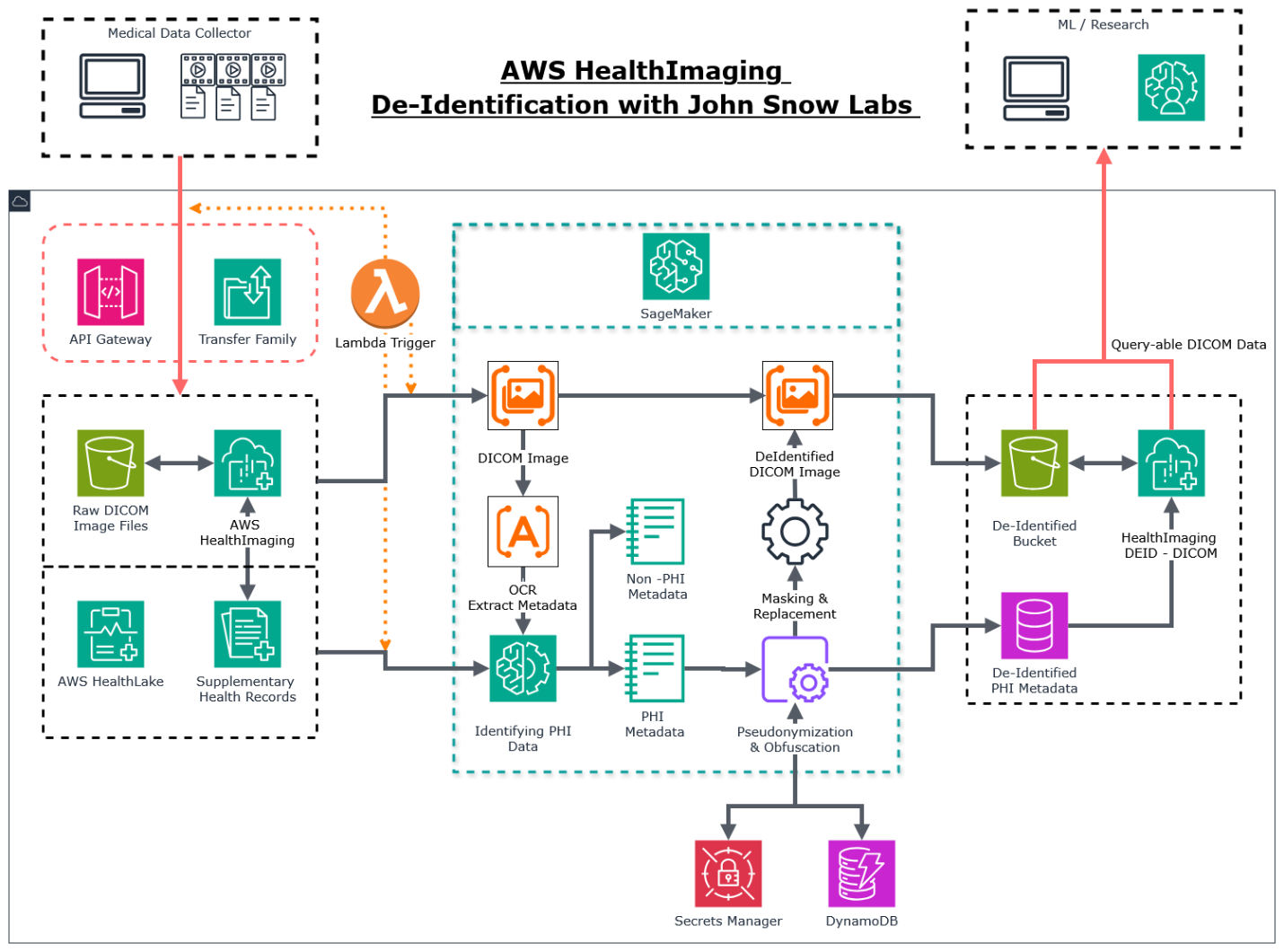John Snow Labs and AWS HealthImaging collaborate to provide a cutting-edge solution that enables secure, customizable de-identification of DICOM files, ensuring compliance while preserving the usability of medical data for research and analytics.
Introduction
Protecting patient privacy is crucial in healthcare, particularly as medical imaging data becomes increasingly vital for research, diagnostics, and AI applications. De-identification of medical data, specifically in DICOM files, ensures that Protected Health Information (PHI) is removed or obfuscated, allowing organizations to comply with privacy regulations while still leveraging the data for valuable purposes.
John Snow Labs, in collaboration with AWS HealthImaging, offers a straightforward de-identification solution for DICOM images and metadata. This solution provides healthcare organizations with a secure, efficient way to anonymize medical imaging data, maintaining privacy and compliance without compromising the data’s usability for research and analytics. The combination of AWS infrastructure and John Snow Labs’ AI-driven technology makes this an effective tool for managing sensitive medical data.
The Challenge of De-identifying DICOM Files
Medical imaging data, particularly in the DICOM format, often contains sensitive patient information embedded in both the images themselves and the associated metadata. This data, referred to as Protected Health Information (PHI), can include patient names, diagnoses, medical history, and other personal details that could potentially be used to identify individuals.
The challenge arises when organizations need to share or use this data for research, analytics, training AI models, or collaboration with other institutions. Without proper de-identification, this sensitive information remains exposed, increasing the risk of privacy breaches. Handling and processing PHI in medical imaging introduces the potential for significant risks, including legal liabilities, regulatory non-compliance, and reputational damage to healthcare providers.
Moreover, the complexity of medical imaging formats like DICOM, which combine both pixel-based image data and structured metadata, makes de-identification even more challenging. Both components need to be anonymized without compromising the data’s analytical or clinical value. The risk is further compounded when sensitive information is inadvertently retained in hidden metadata or image pixel data, creating a serious privacy concern.
How AWS and John Snow Labs Address This Challenge

Overview of the De-Identification Process
The de-identification of medical images and metadata is a critical process to ensure compliance with healthcare privacy regulations such as HIPAA and GDPR. AWS HealthImaging and John Snow Labs provide an AI-powered solution that automates this process efficiently. The approach leverages machine learning to detect Protected Health Information (PHI) in both images and metadata, applying advanced obfuscation and pseudonymization techniques to safeguard patient privacy while retaining the integrity of medical data for research and clinical applications.
AI-Driven PHI Detection and Masking
DICOM Image Processing
- Raw DICOM images are ingested into AWS HealthImaging from various sources, such as hospitals, imaging centers, and research institutions.
- The system extracts textual metadata embedded within the DICOM file and applies Optical Character Recognition (OCR) to scan the image for potential PHI.
- The application also scans the raw image to identify any text and checks if the text in question is PHI in nature.
Metadata Analysis and PHI Extraction
- John Snow Labs’ AI models analyze DICOM metadata to identify sensitive patient information such as names, dates, addresses, and unique identifiers.
- Machine learning models classify each metadata field as PHI or non-PHI, ensuring accurate detection.
Masking and Obfuscation Techniques
- PHI detected in images is either redacted or replaced using synthetic placeholders.
- Metadata fields containing PHI are obfuscated using customizable rules that allow healthcare providers to define the level of anonymization required.
- Techniques such as hashing, tokenization, and encryption are applied to metadata to ensure data security.
Benefits of Customizable Metadata Obfuscation
Flexibility
- Organizations can customize de-identification rules to meet specific regulatory and operational needs.
Data Integrity
- Ensures that research and analytics can be conducted on de-identified data without losing clinical relevance.
Enhanced Security
- Secure storage of PHI mappings using AWS Secrets Manager and DynamoDB for controlled access.
Automation
- Reduces manual effort and minimizes the risk of human error in PHI removal.
Solution Workflow
Step-by-Step Breakdown of the De-Identification Workflow
- Data Ingestion and Triggering the Pipeline
- Raw DICOM images and supplementary health records are uploaded to AWS HealthImaging.
- API Gateway and AWS Transfer Family facilitate data transfer.
- A Lambda function automatically triggers the de-identification process when a new file is detected.
- DICOM Image and Metadata Extraction
- The DICOM image is processed to extract metadata.
- OCR scans the image for embedded PHI such as patient names or dates.
- PHI Identification and Classification
- AI models from John Snow Labs analyze extracted text to detect PHI.
- Metadata is categorized into PHI and non-PHI for further processing.
- De-Identification Process
- JSL Models apply masking and replacement techniques to the metadata.
- Pseudonymization and obfuscation are performed on critical identifiers.
- De-identified images and metadata are securely stored in dedicated AWS storage.
- Storage and Secure Access
- De-identified DICOM images are stored in a secure S3 bucket into a seperate HealthImaging Data Store.
- The obfuscation keys are stored separately in a separate repository. Note – The standard John Snow Labs library doesn’t work in key based obfuscation however there are provisions to allow the end user to perform the same.
- AWS HealthImaging DEID-DICOM allows researchers to query anonymized data.
- Compliance and Security Measures
- All services used this model or a model involving SageMaker as well remain compliant to all GDPR and HIPPA centric compliances.
- AWS Secrets Manager and DynamoDB manage encryption keys and access controls.
- Data processing is conducted in compliance with HIPAA, GDPR, and other relevant healthcare regulations.
- Audit logs are maintained for traceability and compliance reporting.
Ensuring Security, Privacy, and Compliance
End-to-End Encryption
- All data transfers and storage are encrypted.
Access Control
- Role-based access ensures that only authorized personnel can retrieve PHI mappings.
Auditability
- Logging mechanisms track all interactions with the de-identified data.
Benefits for Healthcare Organizations
Enhanced Security, Compliance, and Risk Reduction
By leveraging AWS’s secure cloud infrastructure combined with John Snow Labs’ de-identification technology, healthcare organizations can efficiently protect patient data and ensure compliance with privacy regulations like HIPAA and GDPR. The solution simplifies the complexity of meeting these privacy standards, reducing the risk of costly violations and potential legal consequences. Healthcare organizations can trust that their sensitive data is securely handled, helping safeguard their reputation and financial stability.
Cost and Time Savings Through Automation and Scalability
This soultion helps healthcare organizations avoid the costs associated with on-premise hardware and manual IT management. Seamless integration allows organizations to process large datasets efficiently, saving time and resources. By automating the de-identification workflow, healthcare teams can focus on more critical tasks, reducing operational costs while ensuring their systems scale effortlessly as data volumes grow.
Preserving Data Usability While Maintaining Privacy
Our solution ensures that de-identifying medical imaging data doesn’t compromise its usefulness for research, AI model development, or clinical analysis, fostering collaboration across institutions, and driving innovations in patient care. By improving privacy without hindering the integrity of the data, healthcare organizations can continue to leverage sensitive data for breakthroughs while maintaining the highest level of patient confidentiality.
Eliminating Manual Errors with Automated De-identification
Manual de-identification methods, often relied upon by healthcare organizations, are prone to human error, especially with complex medical imaging datasets like DICOM files. While manual processes can help remove sensitive information, they are time-consuming and require constant oversight to ensure compliance with privacy regulations. They still cannot match the accuracy that our models provide. However, even with careful attention, mistakes can still occur, potentially jeopardizing patient privacy and delaying research efforts.
Conclusion
John Snow Labs’ de-identification solution, integrated with AWS HealthImaging, provides healthcare organizations with a secure, efficient, and scalable way to anonymize medical imaging data. The solution ensures compliance with privacy regulations like HIPAA and GDPR while preserving data usability for research and analytics. By automating the process, it reduces manual errors, speeds up workflows, and enhances data security.
Key benefits include:
- Enhanced Security and Compliance: Ensures sensitive patient data is protected, reducing the risk of privacy breaches and legal issues, while simplifying compliance with regulations like HIPAA.
- Cost and Time Savings: Eliminates the need for costly on-premise infrastructure and manual processes, reducing operational costs and improving efficiency.
- Preserved Data Usability: Maintains the analytical value of de-identified data, enabling collaboration and research without compromising patient privacy.
- Improved Accuracy and Efficiency: Automates de-identification, ensuring consistent, accurate results while speeding up the process and reducing human error.
Healthcare organizations are encouraged to adopt this solution to streamline data handling, improve security, and accelerate research while ensuring patient privacy.






























